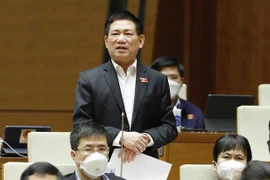 Construction of 4 trillion VND Binh Khanh Bridge, part of the Ben Luc – Long Thanh Highway, crosing the Soai Rap river in the Mekong Delta. (Photo: VNA)
Construction of 4 trillion VND Binh Khanh Bridge, part of the Ben Luc – Long Thanh Highway, crosing the Soai Rap river in the Mekong Delta. (Photo: VNA)Arecent report by the United Nations Development Programme highlighted a numberof the Southeast Asian economy's shortcomings and limitations. From 2002 to2019, public investment (as a share of GDP) was said to fall from 22 percent to11 percent while demand for infrastructure had been increasing.
Thisis especially true in coping with climate change, a rising threat to Vietnam –a densely populated country with two low-lying deltas and a long coastline.
TheSoutheast Asian economy must also commit significant investments to reduce itslogistics costs, transit time, modernise cities and improve digitalconnectivity to stay competitive internationally. While some progress has beenmade, the country is still behind regional rivals such as Malaysia and Thailandon this front.
Innovationhas been slow. Vietnam typically spends just 0.5 percent of its GDP on researchand development in recent years, far below what is required to maintain acompetitive edge in the region. In comparison, Thailand spends over 1 percentand Malaysia close to 1.5 percent.
Tomake matter worse, disbursement of public investment has slowed to a crawlsince the beginning of the year, especially after the fourth outbreak of thevirus in April.
Disbursementof public investment during the first ten months of the year was 257.38trillion VND (11.3 billion USD) or nearly 55.8 percent of the year's target,according to the latest report by the Ministry of Finance.
Evenwhen the money was spent, issues have been raised over its efficiency. Thecountry's decentralised approach has resulted in the fragmentation of itsplanning system in which local projects were approved in isolation and withoutsufficient reference to national strategic priorities. In addition, theimplementation of hundreds of small projects incurred unnecessary costs andslowed delivery.
Thishas called for policymakers to carry out reforms of economic institutions withan emphasis on seeking new sources of long-term financing for itsinfrastructure projects.
Outbreak
Whileinitially experiencing some slowdown, the country was able to mount a strongcomeback in the latter half of 2020, ending the year with positive GDP growth,an impressive feat against a backdrop of a bleak global economy.
However,the fourth outbreak of the virus in Vietnam has been a game-changer. As majortowns, provinces and industrial hubs across the country were forced to go intolockdown during the fourth outbreak, the economy has suffered a massive blow. Vietnam'sGDP growth forecast has been lowered to 2.2.5 percent this year in the latestreport by World Bank.
Arecent survey by the Centre for Analysis and Forecasting of the Vietnam Academyof Social Sciences in July indicated 63.5 percent of Vietnamese householdsexperienced an income drop of at least 30 percent compared to the pre-pandemiclevel, which has resulted in a nosedive in demand for goods and services.
"Vietnam'sfiscal response to the pandemic was inadequate," said Jonathan Pincus,UNDP senior international economist specialised in Southeast Asia.
Pincussaid contraction of private consumption would result in considerable sufferingand slower GDP growth than was necessary. Recovery would be slower because theshortfall of demand would cause bankruptcies.
Heurged policymakers to implement financial reforms and to create new financialinstitutions to increase the supply of long-term credit to finance newinfrastructure and national competitiveness. He also called for curbs onover-lending to properties and equities, a halt to capital inflows duringperiods of excessive credit growth and deficit spending while demand is slowingdown.
VoTri Thanh, former Vice Director of the Central Institute for EconomicManagement (CIEM) and a member of the National Financial and Monetary PolicyAdvisory Council, said the pandemic had forced Vietnam to reconsider theirapproaches to national development and implement policies that wereunprecedented.
"Developingcountries may consider two consecutive quarters with negative growth as arecession. For Vietnam, a 2 percent growth could be considered arecession," Thanh told Vietnam News.
Therehas been a reverse of fortune as Vietnam's GDP growth this year has beenreduced to 2-2.5 percent while the global economy was expected to grow by 5-6 percent.Last year, Vietnam recorded a 2.91 percent GDP growth while the global economywas at negative 4 percent.
"Vietnam'seconomy is not without bright spots including strong macroeconomic indicators,growing exports and a healthy inflow of FDI," he said. However, thegovernment's priorities, for now, were stimulating demand, investment andeconomic recovery.
Thanhsaid the government-sponsored recovery programme must cover and focus on theeconomy's key sectors with fiscal policies to play an important role. Ashort-term budget deficit may be tolerable to shore up the programme'sfinancial strength, he added.
Hecalled on the government to turn the pandemic into an opportunity to initiatereforms and implement new policies to improve productivity and the businessenvironment and to boost innovation and start-up culture./.




























